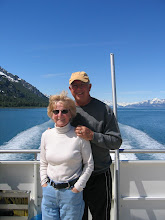Margaret and I flew to Seattle on May 16th and spent the night near the airport. On the 17th our very good friends Gary and Ruth picked us up to make the drive to the boat in Port Angeles. It was about a 2 1/2 hour drive, and we had a good time, stopping for lunch and playing tourist. We arrived at the marina and when we first walk down to the boat after being away for a while, we are always a bit anxious if everything is ok. As usual, there was nothing amiss. We spent a couple days buying groceries, mainly refrigeration items, as we had already stocked canned goods etc. prior to leaving Monterey. Our refrigerator actually pumps sea water through the system in order to cool our food. Inside the fridge and freezer are what we call holding plates. The refrigeration compressor freezes these plates, then shuts down and the plates slowly thaw out. The freezer one is frozen much "deeper" than the fridge plate. Consequently when we are gone we shut the refrigerator completely off so we can't store perishable things. We do this so that we can close the valve that is open to the ocean. The last thing you want to happen is to have salt water coming inside the boat due to a broken hose or other issue and flooding and possibly sinking the boat. The reason for the holding plate is so that when you are at anchor and don't have 120Volt electric available, you can keep food cold. Then during the day you can use the generator to produce electricity and in turn run the refrigerator. We also have an inverter where we convert 12 volt battery power to 120 volt power. This allows us to have a limited amount of 120 electricity without always running the generator. Everything on a boat is more complicated than our houses! Another example is our fresh water system. We have two tanks that each hold 130 gallons of fresh water. When we want to have running water, there is a 12 volt pump that pulls water out of the tank, sends it through two filters, then passes it over a UV light for sterilization before it comes out of a faucet! Washing dishes, brushing your teeth, washing your hands etc. this water drains overboard into the ocean. Taking a shower is another story. My brother in law describes our shower as if you are in a phone booth taking a shower! Also, the water just accumulates in the bottom of the shower, so there is a pump to pull it out of the shower and overboard. Most every pump on board we have a spare as you never know when they might not work. Then you either buy another pump or repair the old one. This is a picture of me rebuilding the shower pump as well as all the pieces inside the rebuild kit.
Now you might be asking, how do the toilets work. I'll save that for a later post.
Inside passage scenery

The trip to Ketchikan was 633 miles, we ran our engines 81 hours and burned 434 gallons of diesel or about 1.45 gallons per mile. Since we haven't purchased diesel, I can't give you the cost, but it is around $4.00 per gallon.
CHUCK AND MARGARET
PS: This year we have taken quite a few videos using our I-phone and have posted them to U-tube. We think these videos give a really good feel for our adventure. If you go to:
Then type into the seach box our address:
chuckherr1
You will be taken to the videos.
























